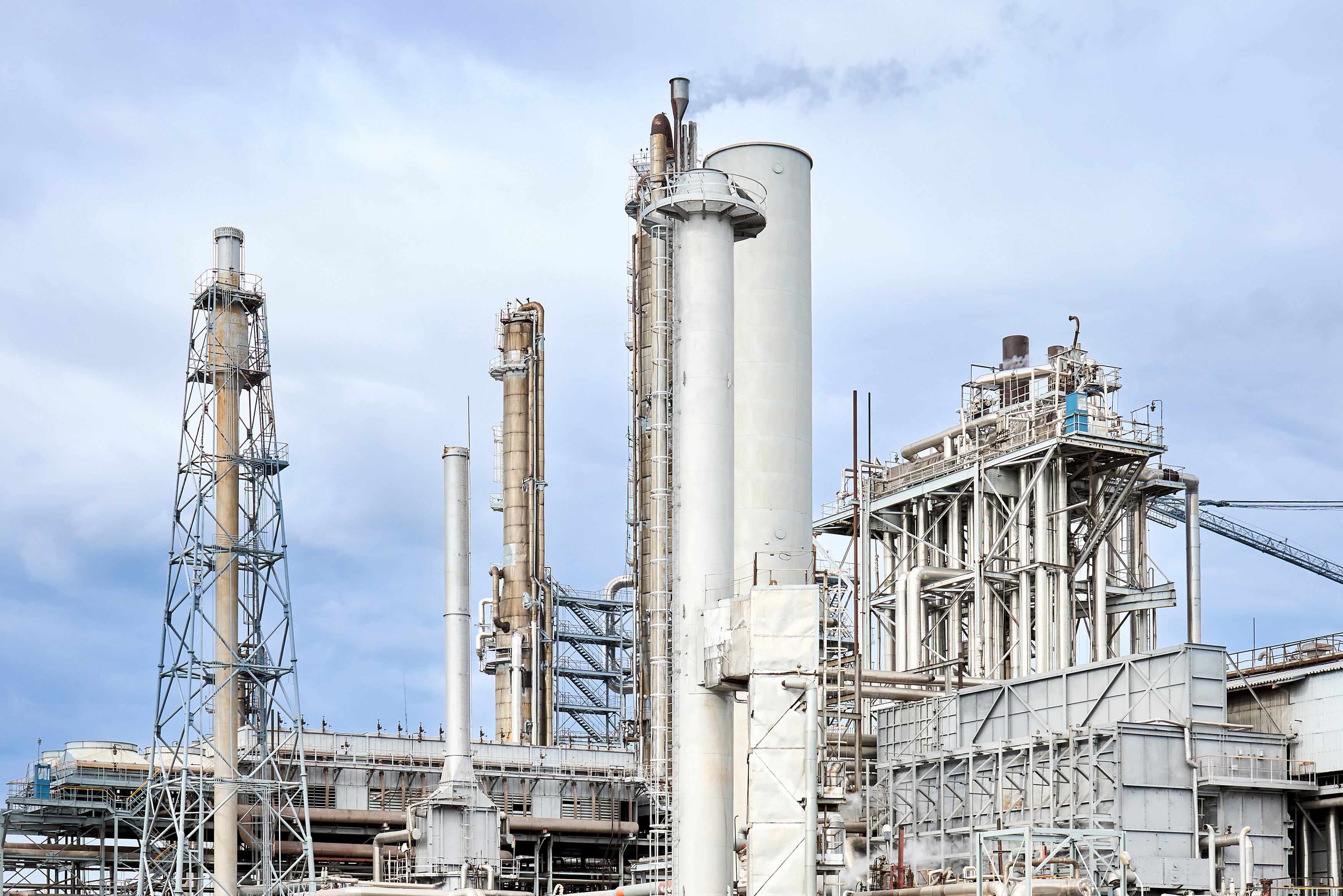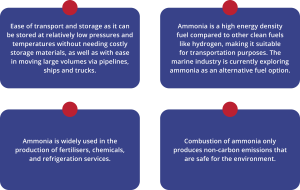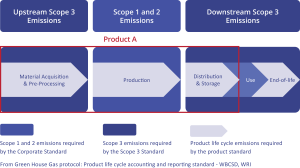Ammonia as an Alternative Energy to Fossil Fuels

Tan Wooi Leong
Managing Director, Surbana Jurong
Cliff Chuah Khiok Eng
Deputy Director (Innovation), Surbana Jurong
Himanshu Kishorkumar Majeethia
Senior Manager (Energy & Industrial), Surbana Jurong
Climate change is a global threat due to rising temperatures, air pollution and other contributing factors. Immediate steps must be taken in search of non-fossil sources of fuel that are sustainable in order to address its consequences.
Ammonia could provide one such sustainable option.
Climate change is undeniable, and humanity now faces the urgent need to mitigate and adapt to its effects. Human activity is at fault, contributing greatly to warming by emitting large volumes of greenhouse gases into our atmosphere. Governments around the globe are moving towards using low-carbon fuels with reduced carbon emissions to help decarbonise our planet, as coal, natural gas and oil, and oil products combustion is one of the primary contributors of greenhouse gases emissions. Rising demand for energy requires greater emphasis on finding cleaner and sustainable sources.
Ammonia – an inorganic chemical composed of only nitrogen and hydrogen – may serve as an excellent and sustainable alternative to fossil fuels. Decarbonisation offers another strategy for lowering carbon emissions. This process entails eliminating or reducing carbon emissions through Carbon Capture and Utilization Systems (CCUS), while employing non-carbon sources of energy as potential solutions. Alternative fuels like ammonia and hydrogen may be used as renewable sources of energy production, though their lower energy density makes these resources unsuitable for certain applications and is expensive to transport and store.
Ammonia could be one of the best resources to meet carbon reduction goals. It can be produced using hydrogen that is from renewable energy sources, or through conventional processes that capture and store carbon emissions.
As an energy carrier that can contribute to decarbonisation efforts, ammonia has an exceptional energy density compared to hydrogen.
While ammonia has long been used as an industrial chemical and nitrogen fertiliser, it could soon also serve as fuel, with new applications including transportation and power generation.
Ammonia as a Fuel
Ammonia is an inert, colourless gas with strong alkaline properties. It is highly water soluble and readily absorbed by soil and plants. Ammonia can also be transported as refrigerated liquid in ships since it can be easily compressed under pressure. The Haber-Bosch process is the primary method in producing ammonia from nitrogen and hydrogen. Ammonia was initially proposed as an energy carrier due to high energy density than liquid hydrogen and reduced storage and transportation risks. Furthermore, ammonia production can take advantage of renewable energies like solar power, wind power or geothermal power and this helps lower greenhouse gases emitted into the environment.
Ammonia, as an internal combustion engine fuel source, is not new; ammonia was first used commercially as early as 1900s but was not widely accepted due to concerns of toxicity. Ammonia-powered engines and turbines are being developed today, but these innovations need to meet modern safety and efficiency requirements before becoming widely adopted.
Ammonia as a Sustainable Fuel
Green ammonia can play an instrumental role in providing cleaner and sustainable energy to the world, acting as both fuel and carrier to decarbonise various sectors and help governments meet greenhouse gas emission goals.
Manufacturing ammonia with conventional fossil fuel sources is expensive, whereas harnessing solar or wind power in ammonia production would make ammonia an even more sustainable energy source.
Advantages of Ammonia
Ammonia offers several key benefits as a fuel, including:

Challenges Associated with Ammonia Usage
While Ammonia offers numerous advantages, its usage also presents considerable challenges. Four examples are listed below:
- Ammonia can be toxic at high concentrations (30PPM or greater), flammable (15-28 per cent by volume) and highly corrosive.
- Ammonia also poses environmental and safety risks at certain volumes. Given below are the levels of exposure to ammonia on the human body.
- Production costs are higher as the Haber-Bosch Process requires considerable amount of energy consumption. If excess low-cost green energy is available, green ammonia production could serve as an excellent energy storage medium and even save on production costs.
- To produce a large volume of ammonia and increase infrastructure development of ammonia production, strong support from governments and citizens is required.

Regulatory Challenges
Ammonia presents several daunting regulatory hurdles to organisations working across sectors like Energy, Transport, Marine and Environmental Protection. Current frameworks may not suffice in handling, transporting and storing ammonia safely as volume grows. Furthermore, it should evolve with technological developments. It is strongly recommended to consult with the regulators early to ensure no major hurdles in the later stages of project development.
Safety Challenges
The storage and handling of ammonia present several unique safety concerns, as its volatile form is a highly toxic and flammable gas that could pose a danger to both equipment and human health. Inhalation of ammonia at high concentrations may even result in death. Therefore, companies involved with ammonia production and storage must follow certain safety regulations to protect workers as well as the general public. These regulations include providing proper ventilation systems, personnel protective gear (such as gloves and masks), employee training, emergency shut-off systems with integrated pipe-in-pipe concepts to reduce leakage frequencies, as well as water curtains to absorb ammonia quickly in the event of a leakage.
Ammonia and Environmental Challenges
Nitrogen oxides (NOx) emissions present power plants with significant challenges when not managed carefully, leading to health and environmental concerns. Selective Catalytic Reactor (SCR) technology may help to combat such emissions more effectively. SCR technology from gas turbine manufacturers can also be used as one of the solutions to combat NOx problems.
Certification
In order to support the development of a low and zero-carbon ammonia market, the establishment of a globally harmonised certification scheme for low-carbon ammonia is critically needed. The current ways of verifying the authenticity of ammonia type is via third party or government certification schemes which provide the Guarantees of Origin (GO).
As a hydrogen derivative, ammonia certification will follow closely the parameters for hydrogen certification. The certification parameters follow the International Partnership for Hydrogen and Fuel Cells in the Economy (IPHE) methodology (IPHE,2022), which is in the process of being established as an International Organization for Standardization (ISO) standard.
International Partnership for Hydrogen and Fuel Cells in the Economy (IPHE) Methodology
The IPHE developed a mutually agreed methodology for determining greenhouse gas emissions associated with the production of a unit of ammonia as a hydrogen carrier. The methodology applies known life cycle assessment standards such as ISO 14040, 14044, 14067 and GHG Protocol. System boundaries are typically defined to “well-to-user” (as seen in the diagram below; from material acquisition and pre-processing to production to distribution and storage) pathway. The distribution and storage include conditioning to hydrogen carriers and transportation to the user gate. It also addresses the emissions inventory, treatment of renewable electricity, fugitive emissions and systems allocation.

Chain of Custody
To ensure that the purchased commodity carries credible emission reduction benefits, an administrative record must track the flow of the product through the entire supply chain. This is referred to as a chain of custody (CoC) model.
The objective of the CoC model is to validate claims made about the product, process, business, or service covered by the sustainability standard. This is achieved by defining a set of requirements and measures that provide necessary controls on the movement of material or products, and associated sustainability data, from approved or certified businesses through each stage of the supply chain. Many standard systems set a CoC standard for this purpose, in addition to their production or management standard.
CoC models have varying levels of coupling between the product and the sustainability claim and can use identity preservation, segregation, mass balance or book-and-claim methods (as defined in ISEAL, International Social and Environmental Accreditation and Labelling Alliance). The most prominent models used are the book-and-claim and mass balance models. In the book-and-claim model, ammonia providers can “book” the renewable ammonia they have produced in their systems and energy customers then “claim” the energy they have consumed as renewables. The certified material is completely and physically decoupled from the sustainability data. Book-and-claim model is therefore a mechanism of pure certificate trading. On the other hand, mass balancing links the certificate with the respective physical delivery of the energy carrier. The volume of certified product entering the operation is controlled and may mix with non-certified product.
This is provided that the volume of certified product is balanced at the output. The volumes can be balanced at the batch, site or group level.
Digital blockchain-based tools can assist in delivering these CoC models – some examples include IHI Ammonia Carbon Dioxide Traceability Platform, Green Token by SAP, Siemens Energy Clean Energy Certificate and Acciona Energia GreenH2Chain®.
Conclusion
As governments worldwide prioritise sustainable energy solutions to meet their decarbonisation initiatives, opportunities will open up for alternative fuels such as ammonia and hydrogen to compete. Ammonia could play an essential part in carbon reduction efforts if certain conditions such as safety and costs are fulfilled. Significant investments may be needed if its usage should increase significantly and provide viable climate change solutions. Governments and industries should collaborate on creating policies and incentives which can promote ammonia as a sustainable fuel for bunkering and power generation, thus contributing to decarbonisation initiatives without becoming an impediment.
Recall some decades back when fuels like petrol, diesel and gas were looked upon with suspicion before eventually becoming mainstream sources of energy, thank to the careful research in this area. Ammonia, as a high density energy source, may provide us an ideal way to save the environment by limiting greenhouse emissions and help future generations.


